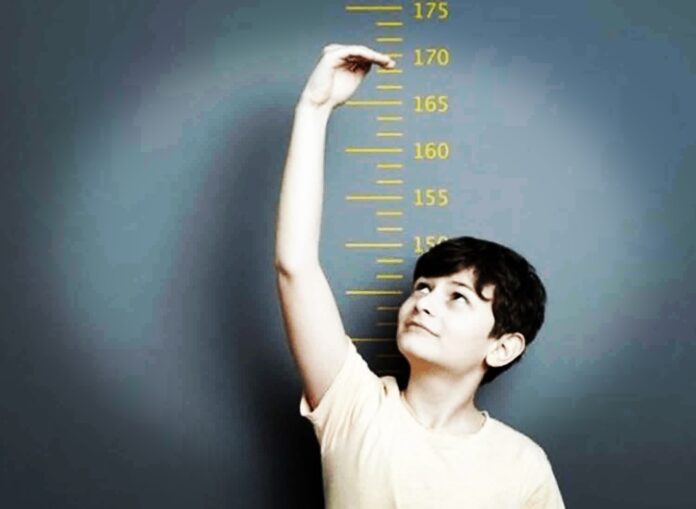
what’s the 13 reason why some children’s Height doesn’t increase properly
There are several reasons why some children may experience a delay or slow rate of growth in terms of height. Height is influenced by a complex interaction between genetic, environmental, and nutritional factors. While genetics plays a significant role in determining height, it is not the only factor, and environmental and nutritional factors can also have a significant impact on a child’s growth.
In this article, we will explore some of the most common reasons why some children may not reach their full height potential and what parents can do to help promote healthy growth and development.
Genetics:
Genetics plays a significant role in determining a child’s height. Height is a highly heritable trait, with studies suggesting that up to 80% of height variation is due to genetic factors. Height is primarily determined by the interaction between multiple genes, with each gene contributing a small amount to a child’s final height.
A child’s height potential is largely determined by their parent’s height, with tall parents generally producing taller children, and shorter parents producing shorter children. However, it is important to note that genetics is not the only factor influencing height, and environmental and nutritional factors can also have a significant impact.
Nutrition:
Nutrition is a critical factor in a child’s growth and development. A balanced diet that includes sufficient amounts of protein, vitamins, and minerals is essential for healthy growth. A lack of proper nutrition can lead to stunted growth and delayed development.
Protein is particularly important for growth, as it is the building block of tissues in the body, including muscles, bones, and organs. A lack of protein can lead to a delay in growth, as the body does not have the necessary materials to build and repair tissues.
Vitamins and minerals are also essential for growth and development. For example, vitamin D is necessary for the body to absorb calcium, which is critical for bone growth. A lack of vitamin D can lead to weak bones and stunted growth. Iron is another important nutrient, as it is necessary for the production of hemoglobin, which carries oxygen to the body’s tissues. A lack of iron can lead to anemia, which can cause fatigue and a delay in growth.
Hormonal Imbalances:
Hormonal imbalances can also affect a child’s growth and development. The pituitary gland produces growth hormone, which is responsible for stimulating growth in children. If there is a problem with the pituitary gland, such as a tumor or injury, it can affect the production of growth hormones and lead to stunted growth.
Thyroid hormones also play a role in growth and development. A lack of thyroid hormone can lead to delayed growth and development, as the thyroid hormone is responsible for regulating the body’s metabolism and energy levels.
Chronic Illness:
Chronic illnesses can also affect a child’s growth and development. Illnesses that cause inflammation in the body, such as Crohn’s disease, can lead to malnutrition and delayed growth. Chronic illnesses that affect the lungs, such as cystic fibrosis, can also lead to delayed growth, as the body requires more energy to breathe and maintain normal lung function.
Emotional Stress:
Emotional stress can also affect a child’s growth and development. Chronic stress can lead to the release of stress hormones, such as cortisol, which can interfere with the production of growth hormones and lead to stunted growth. Emotional stress can also affect a child’s appetite and eating habits, which can lead to a lack of proper nutrition and delayed growth.
Medications:
Certain medications can also affect a child’s growth and development. For example, corticosteroids, which are often used to treat asthma and other inflammatory conditions, can interfere with the production of growth hormones and lead to stunted growth. Chemotherapy and radiation therapy can also interfere with a child’s growth and development, as they can damage healthy cells and tissues in the body.
Sleep:
Sleep is essential for growth and development, as it is during sleep that the body releases growth hormones. Children who do not get enough sleep may not produce enough growth hormone, which can lead to delayed growth.
Physical Activity:
Physical activity is also important for healthy growth and development. Regular exercise helps to build strong bones and muscles, which are essential for healthy growth. Children who are sedentary or do not get enough exercise may have weaker bones and muscles, which can lead to delayed growth.
Chronic Diseases:
Chronic diseases such as kidney disease and diabetes can also affect a child’s growth and development. These diseases can lead to a lack of proper nutrition, as well as hormonal imbalances that can interfere with growth.
Puberty:

Puberty is a critical period of growth and development, as it is during this time that children experience a significant growth spurt. However, the timing and duration of puberty can vary widely among children. Some children may experience delayed puberty, which can lead to delayed growth.
What Can Parents Do?
There are several things that parents can do to help promote healthy growth and development in their children:
Provide a balanced diet that includes sufficient amounts of protein, vitamins, and minerals.
Encourage regular physical activity to build strong bones and muscles.
Ensure that their children get enough sleep, as this is when the body releases growth hormones.
Encourage their children to manage stress and provide emotional support.
Seek medical attention if they suspect a problem with their child’s growth and development.
Ensure that their children are up to date on all vaccinations, as some diseases can affect growth and development.
Conclusion:
Height is influenced by a complex interaction between genetic, environmental, and nutritional factors. While genetics plays a significant role in determining height, it is not the only factor, and environmental and nutritional factors can also have a significant impact. Parents can help promote healthy growth and development by providing a balanced diet, encouraging regular physical activity, ensuring that their children get enough sleep, and seeking medical attention if they suspect a problem with their child’s growth and development. By taking these steps, parents can help their children reach their full height potential and promote overall health and well-being.
best exercises for increasing children’s height

While exercise is important for overall health and well-being, there is no specific type of exercise that is known to increase a child’s height. However, regular physical activity can help promote healthy growth and development by building strong bones and muscles.
Here are some types of exercises that can be beneficial for children:
Weight-bearing exercises:
These exercises involve supporting your body weight and can help build strong bones. Examples of weight-bearing exercises include running, jumping, skipping, and dancing.
Strength training exercises:
Strength training exercises can help build strong muscles, which are important for overall health and well-being. However, it is important to use appropriate weight and proper form to avoid injury. Examples of strength training exercises include push-ups, sit-ups, and squats.
Stretching exercises:
Stretching exercises can help improve flexibility and range of motion, which can be helpful for overall health and well-being. Examples of stretching exercises include yoga, Pilates, and stretching routines.
Swimming:
Swimming is a great form of exercise that can help build strength and endurance. It is also a low-impact exercise that is easy on the joints, making it a good option for children who may have joint problems.
Cycling:
Cycling is another low-impact exercise that can help build leg strength and endurance. It is also a fun activity that can be done with friends or family.
Sports:
Participating in sports such as soccer, basketball, and volleyball can help build strength, endurance, and coordination. It is also a fun way for children to stay active and make friends.
Jumping rope:
Jumping rope is a great cardiovascular exercise that can help build endurance and coordination. It is also a fun activity that can be done alone or with friends.
Martial arts:
Participating in martial arts such as karate, judo, or taekwondo can help build strength, endurance, and coordination. It can also help children develop discipline and self-confidence.
It is important to encourage children to engage in physical activity that they enjoy, as this can help them develop a lifelong love of exercise and physical activity. However, it is important to ensure that children are engaging in safe and appropriate activities for their age and skill level.
When should I be concerned about my child’s growth
It is important for parents to monitor their child’s growth and development, as this can be an indicator of overall health and well-being. Here are some signs that may indicate a problem with a child’s growth:
Slow growth:
If a child’s growth rate is consistently below the 3rd percentile for their age and gender, this may indicate a problem with growth. However, it is important to remember that children grow at different rates, and some children may naturally be smaller or shorter than others.
Delayed puberty:
If a child has not started puberty by age 14 for girls or age 15 for boys, this may indicate a problem with growth and development.
Lack of height gain:
If a child is not gaining height as expected, this may indicate a problem with growth. However, it is important to consider factors such as genetics, nutrition, and overall health before becoming concerned.
Short stature:
If a child is significantly shorter than their peers, this may indicate a problem with growth. However, it is important to consider factors such as genetics and family history before becoming concerned.
Delayed motor skills:
If a child is not meeting developmental milestones for their age, this may indicate a problem with growth and development.
If you are concerned about your child’s growth and development, it is important to talk to their pediatrician or healthcare provider. They can evaluate your child’s growth and development and determine if any further testing or evaluation is needed.
2 growth disorders
Several growth disorders can affect children’s growth and development. Here are two examples:
Growth hormone deficiency:
Growth hormone deficiency (GHD) is a condition in which the body does not produce enough growth hormone, which is necessary for normal growth and development. Children with GHD may have slower than normal growth, delayed puberty, and may be shorter than their peers. Treatment for GHD may involve growth hormone injections, which can help promote normal growth and development.
Turner syndrome:
Turner syndrome is a genetic condition that affects girls and women. It occurs when one of the two X chromosomes is missing or partially missing. Girls with Turner syndrome may have a variety of symptoms, including short stature, delayed puberty, and infertility. Treatment for Turner syndrome may involve growth hormone injections to promote normal growth and development, as well as hormone replacement therapy to address issues related to puberty and fertility.

















